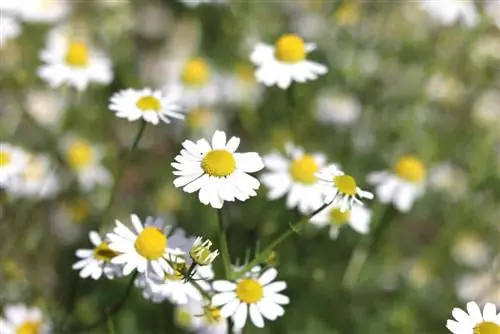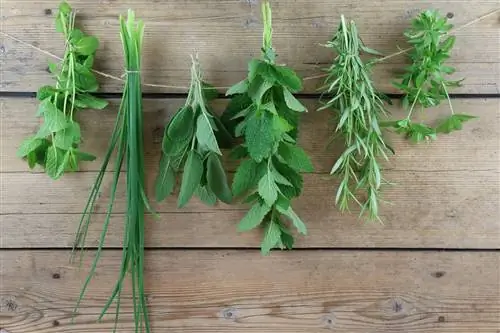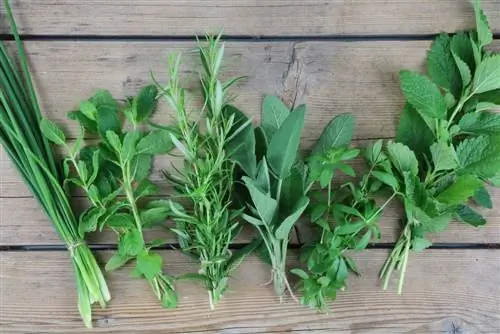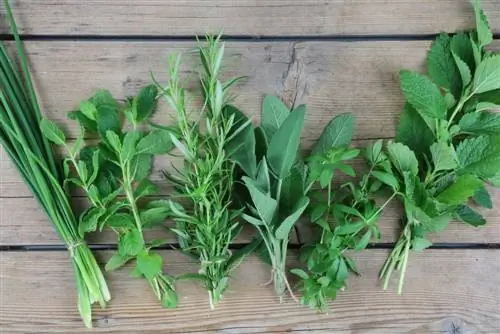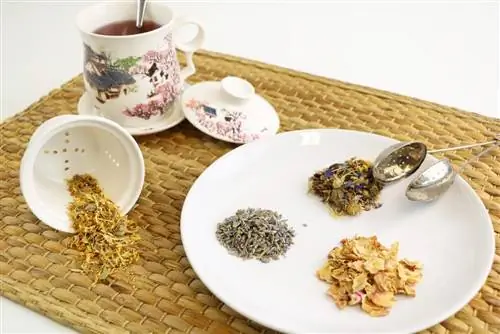- Author admin [email protected].
- Public 2023-12-17 03:39.
- Last modified 2025-01-24 12:45.
Herbs can be used in numerous ways. In addition to their use in the kitchen, they have been used by people as tea herbs for thousands of years. The variety of herbs that you can grow on your own is particularly extensive. All you need is a little space, be it on the balcony or in the garden, and the right plants.
What is herbal tea?
Herbal tea refers to a variety of different tea products that come from the harvested parts of various plants. It is important to know how a herbal tea differs from a fruit tea, for example, so that you are sure about what you are harvesting for the tea. This distinction becomes difficult due to the different names used for the individual parts of the plant. The following parts of a plant are mainly used for herbal tea:
- leaves
- Flowers
- Shoots
- shoot tips
- Roots
In addition to herbal teas and real teas made from Camellia sinensis, fruit teas are the third major category. These are obtained from the fruits of the plants that are dried. These include, for example, rose hips, raspberries or elderberries. For the classic herbal tea, below you will find 20 typical herbs that you can use to infuse. You can also find out how to grow herbs successfully in the following sections. Many of the plants have one advantage: they can be grown in containers, which is ideal for people without a garden. This way you can even grow herbs for tea right in your kitchen or on the balcony.
Note:
Bark tea is another type of tea that you can easily make yourself. For this you will need pieces of bark from trees such as oak and willow, but these are not really called tea herbs.
20 herbs for tea

The world of tea herbs that you can grow yourself is large. There is a wide variety of herbs waiting for tea lovers in their local or climatically similar regions. The following list gives you an overview of 20 tea herbs that you can grow yourself. You can also find out which plant parts you can use for herbal tea.
Tea herbs A to G
Field horsetail (bot. Equisetum arvense)
Field horsetail, like nettle, can not only be used in the garden, but also tastes good as a tea. To do this, simply pour on whole shoots.
Arnica (bot. Arnica montana)
Arnica is said to have a positive effect on the cardiovascular system and is therefore often drunk as a herbal tea. The flowers are used for this.
Valerian (bot. Valeriana officinalis)
The calming effect of valerian is also possible as a tea. To do this, either harvest and dry the roots in autumn or use the flowers.
Stinging Nettle (bot. Urtica)
The nettle is one of the best-known wild herb species that you can keep in the garden with little effort. If you are interested in nettle tea, use the leaves, which you should either pick very carefully or only with gloves. Stinging nettles continue to reproduce excellently on their own and sometimes have to be curbed in growth.
St. John's Wort (bot. Hypericum perforatum)
St. John's wort is described as a frequently used tea ingredient for relaxed nerves. For this you use the flowers, shoots and leaves, which makes the yield correspondingly high with good care.
Daisies (bot. Bellis perennis)
Daisy tea is made from the flowers that you infuse with hot water. The taste will be reminiscent of chamomile.
Common Yarrow (bot. Achillea millefolium)
Yarrow is also planted on the leaves. The slightly bitter aroma may be reminiscent of chamomile, but it is still clearly distinguishable. Yarrow tea is very suitable for stomach problems.
Ginkgo (bot. Ginkgo biloba)
Ginkgo leaves are used for tea. These are harvested, chopped and then brewed. Afterwards the herbal tea can be enjoyed.
Tea herbs H to R
Elderberry (bot. Sambucus)
If you want to drink elderberry tea, elderflowers are ideal for this. These are harvested from May to early August and infused either fresh or dried. Elderflower tea is a poem, especially with honey.
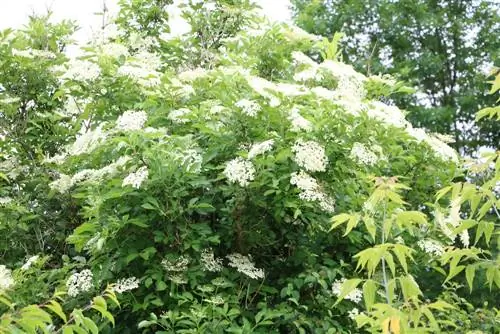
Ginger (bot. Zingiber officinale)
The tuber is used here. Cut them as thinly as possible, as larger cutting surfaces allow more flavor to be released.
Chamomile (bot. Chamaemelum)
Chamomile tea should not be missing in any household and has numerous he althy properties for the body. They can be widely grown, harvested and even used fresh in tea. The plant also has high ornamental value. 2. Dandelion (bot. Taraxacum sect. Ruderalia): Dandelion is just as popular as a tea, as are nettles. The roots and leaves of the well-known “weed” have been used for tea and even a coffee alternative for centuries. Can also reproduce quickly on its own.
Mints (bot. Mentha)
Mint tea is a classic and even popular with children. Here they mainly use the leaves of species such as Moroccan mint (bot. Mentha spicata 'Morocco'), apple mint (bot. Mentha suaveolens), peppermint (bot. Mentha piperita) or spearmint (bot. Mentha spicata). You should not choose polei mint as it contains toxins.
Roselle (bot. Hibiscus sabdariffa)
The roselle is used in the same way as the mallow. It's just that the finished herbal tea is usually lighter.
Tea herbs S to Z
Sage (bot. Salvia)
Sage tea is a popular classic and should not be missing in any kitchen. The intense taste is enhanced by hot water and can even be varied by the type or variety used.
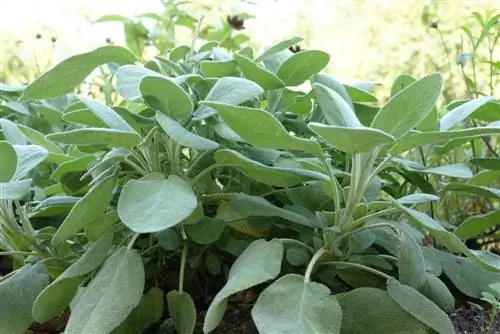
Thyme (bot. Thymus)
Thyme is not suitable for cooking, but rather an aromatic tea that you can easily grow yourself. As with dishes, be sure to use the whole shoots.
Wormwood (bot. Artemisia absinthium)
Herbal tea can even be brewed from wormwood. To do this, simply harvest the leaves and brew them fresh. This drink has an intensely stimulating effect.
Wild mallow (bot. Malva sylvestris)
With mallow, use the flowers to make an aromatic herbal tea that has a deep red color. To do this, you have to dry them first.
Lemon balm (bot. Melissa officinalis)
One of the most popular tea herbs for your own garden. The lemon flavor is particularly noteworthy here. To do this, simply pluck off a few leaves.
Lemon Verbena (bot. Aloysia citrodora)
Simply use the lemon verbena herb and dry it for an aromatic drink. The citrus aroma is pleasantly intense.
Note:
Another classic for your own teas are birch leaves, but they are much more difficult to harvest if you don't have your own birch (bot. Betula) in the garden. You can either collect birch leaves in the forest or city parks or purchase an already grown specimen and plant it in your garden, as complete reseeding will take decades.
Growing tea herbs
Once you have decided on some of the plants mentioned above, you can start growing the plants. It is not only important to pay attention to the needs of the herbal plants, but also to their growth rate. Fruit teas, for example, have the characteristic that you have to wait a few years after cultivation until berries or other fruits form. This is not the case with herbal teas. Of the species mentioned above, classic wild herbs in particular grow very quickly and, in contrast, require little care:
- Mints
- Stinging nettles
- Lemon balm
- Lavender
- Sage
- Chamomile
- Daisies
- Dandelions
- St. John's Wort
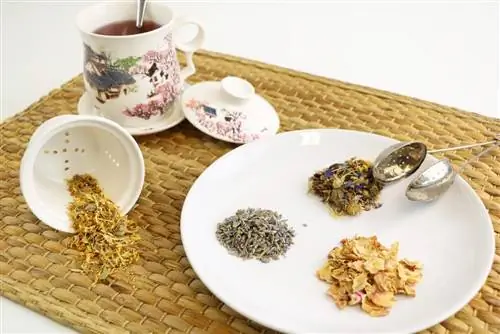
These tea herbs literally spring up when you distribute seeds in spring. Although the other plants are not slow, they require significantly more care. Plants such as mallow, roselle, elderberry and ginkgo require more than one season to form sufficient plant material. It is best to use a specimen that is large enough or an offshoot or cutting to accelerate growth. In contrast, there are tea plants whose tubers are used. For example, you harvest ginger bulbs in autumn and have them available throughout the winter. If you want to grow your own herbal teas, you should pay attention to the following care points to improve growth and preserve as much plant material as possible:
- Location
- Water supply
- Time of reproduction
Far too often, people forget to fertilize their herbs, because they can only grow lushly with sufficient nutrients. This is particularly important for the plants from which you use the leaves. Choose appropriate fertilizers to improve either flower or foliage production. With mallows, for example, you should stimulate flower formation, while mints need more strength in the leaves. You can also always use substrate that is enriched with sufficient nutrients. This is important for the herbal plants to be able to produce the essential oils that are needed for the taste and effect of the tea. The final aspect is the choice between planter and bed:
- local plants: bed
- non-native herbs: pots
Local tea herbs such as mint, chamomile or field horsetail can easily be sown outdoors. An elderberry is also ideal for your garden. But if you want to grow ginkgo or ginger yourself, you definitely have to put them in a pot as they would never survive the winter outdoors. This is a necessity, especially with perennial plants. Also, never let your tea herbs dry out. That's not really good for them.
Tip:
If you take herbs from the supermarket or even a specialist shop in a plant pot, you should always repot them immediately or place them in fresh, nutrient-rich soil in the bed. This makes the herb plants feel much more comfortable and thrive.

